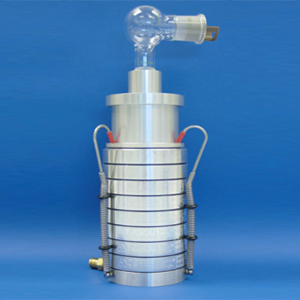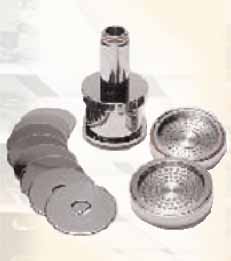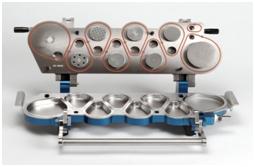A3G – Automated Andersen Cascade Impactor
There are several impactors available on the market for measuring particle size distribution from inhaled drugs or an air sample.
“Andersen Cascade Impactor or ACI, has been the impactor of choice, and to date almost all of the particle size distribution data submitted to the FDA has been obtained using the ACI. Particle sizes in the 1 to 5 micron range penetrate get deep into the lungs, permitting ready absorption of the drug into the blood, and thus are most efficacious. For this reason the US FDA and other regulatory agencies throughout the world requires extensive particle size distribution data from the drug companies”.
However the ACI greatly suffers from low productivity, typically two to four dose determinations per day and from operator induced data variability. At about two dose determinations per day, doing the test manually, it takes years to generate the data and get regulatory approval from the FDA.
The Next Generation Impactor or the NGI was invented to overcome the low productivity issues experienced by the Andersen Cascade Impactor. Traditionally it was thought that the ACI is impossible to automate. Many companies have switched to the NGI and as more and more people have begun using it, they too have experienced issues with it this then is not the answer that most people thought it would be. Typically users can get four to ten dose determinations per day per operator.The “A3G” is a third generation impactor that has all the advantages of the first and second generation impactors (the ACI and NGI) with none of the disadvantages of either technology.
The Andersen Cascade Impactor(ACI)
 The ACI consists of a cascade of discs stacked, one on top of each other and sealed from the environment, as shown in the picture on the left.
The ACI consists of a cascade of discs stacked, one on top of each other and sealed from the environment, as shown in the picture on the left.
Vacuum is applied to the brass pin as seen on the picture on the left, and a constant airflow set up through the ACI.
The inhaler is attached to the glass throat on top of the impactor and the drug is inhaled by the impactor. Drug particles of differing particle size get deposited on to different discs, with the bigger particles on the top and smaller particles on the bottom. After drug injection, the 22 components of the ACI must be disassembled in a clean room, and each of its components washed, weighed, dried and samples are collected in duplicate from each disc and HPLC technique is used to determine the drug content. Assuming mass balance, the particle size is deduced from the layer it was collected and the particle size distribution for the dose is drawn up. The data from each process step has to be accurately recorded. Thus the process is slow there are many opportunities for errors when this process is manually executed.
In order to understand the limitations of the technologies, we need to understand the technologies.
The Next Generation Impactor or the NGI
The picture on left shows the Next Generation Impactor. To increase productivity the number of individual parts has been reduced considerably. All of the cups shown in the bottom of the picture are integrated into a tray thus the operator has to handle a tray at a time. However the scope for automation is limited to solvent dispensing and sample collection. The washing is still all manual. The air passages are integrated into the body of the impactor (visible as large holes in the picture). They are difficult to clean and lead to drug accumulation and cross-over data errors. Further, the flight path of the aerosol particle is twice as long as in the ACI. This long path leads to droplet evaporation in case of the pMDI, and the errors tend to be biased towards fine particle fraction. To prevent droplet evaporation, scientists have to freeze/cool the NGI prior to use, making its productivity much lower than claimed and the process very expensive.
The A3G
Comparison of the A3G technology vs. the NGI:
| A3G | NGI | |
| Productivity | 40 Dose Determinations per day | Four to ten Dose determinations per day per operator |
| Flight path of the aerosol particles | Same as in the ACI | At least twice as long as in the ACI. To prevent aerosol droplet evaporation, many people have started to freeze their NGIs prior to use, thus severely restricting throughput and increasing cost. Without the freezing step, the data is biased more towards the fine particle fraction. |
| Mass Balance | >98% Mass Balance is obtained, same as manual Andersen Cascade Impactor. All parts get cleaned between each experiment | Much poorer mass balance then the ACI as powder drug accumulates in the passageways integrated into the body of the NGI, which are difficult to clean. Without periodic cleaning the accumulated drug in the passageways will spike release with the flow onto the collection cups, causing data spikes and crossovers between experiments. Again this limits the actual productivity obtained with the NGI. |
| Impactor Plate/cup handling | No handling of any plates/cups | Requires manual cup handling for sample processing, increases chances of analyst error, and limiting throughput |
| Plate/cup Saturation | Particles are distributed evenly over greater surface area than NGI (more surface area, better adhesion of particles) | NGI has fewer jets per stage therefore concentrating impacting particles on a smaller surface area. |
| Air Flow | Up to 90 liters per minute with minus stages | Up to 100 liters per minute |
| Plate Coating for DPIs | No coating required | Requires that cups/plates be coated |
The A3G makes it possible to get an inhalation drug to the market years earlier than has been possible in the past because of the very high throughput (40 dose determinations per day (depending on the SOP)).
While others have attempted to automate this very complex test by mimicking the human operations by replacing it with a robot, we have fundamentally altered the way this is automated without in any way changing the integrity if the ACI, and thus the automation does not require bridging studies to correlate new data with historical data.
Other advantages of automating the ACI:
- HPLC vials are filled for the analyst.
- HPLC vials are stored in cooled racks,preventing sample evaporation.
- Software is CFR21-Part 11 compliance capable.
- We prepare validation document.
Emitted Dose Sample Prep Automation
This system automatically prepares samples for analysis from the emitted dose from an inhaler. A burst from the Metered Dose Inhaler is sprayed into the Collection Chamber of this machine. The machine then adds a programmed volume of Internal Standard, and washes the spray from the inhaler with a specified solvent, mixes it, and collects it in duplicate in an HPLC vial, which is stored in a thermoelectrically cooled Sample Storage Rack.
- Single dose sample prep every 10-14 minutes
- Undetectable level of carry-overs
- Sample injector counter
- Stores samples directly in HPLC vials
- To minimize solvent evaporation, HPLC vials stored in cooled sample rack
- This System is controlled using an embedded control system running Win CE.
- The System has a closed loop control to maintain vacuum induced flow.
Karl Fischer Moisture Determination Automation
This automated system determines the moisture content in an MDI can. It punctures the MDI can, prepare sample, and initiates the Karl Fischer Titrator. It is CFR 21 compliance capable.
- The Automated Karl Fischer Titration System will allow 24 moisture determinations per day in a controlled environment, as against 6 to 9 moisture determinations per day possible by the manual process.
- The system consists of a pMDI can piercing apparatus, methanol pump, a humidity controlled glove box and an assortment of valves, and an embedded control system with a Windows 2K front end.
- The automated system frees up the analyst for more productive tasks.
- Better data quality is possible with the automated system because:
- No need for repeated movement of hands in and out of the glove box.
- The humidity inside the automated system is controlled.
- Stable & minimal humidity environment ensures sample solution integrity
- Automation prevents analyst fatigue, which again leads to errors.
